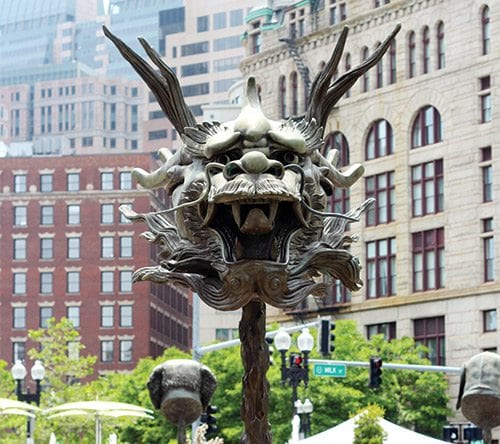The Year of the Monkey
Ai Weiwei sculpture brings art into public sphere

For Boston, 2016 is the year of Ai Weiwei. The renowned Chinese artist started his takeover of the city with several pieces in the Museum of Fine Arts, Boston’s Megacities Asia exhibit. But more impactful than the untouchable sculptures in the city’s cultural shrine is his public art piece Circle of Animals/Zodiac Heads, currently on view on the Rose Kennedy Greenway.
What makes this piece striking isn’t the scale — each zodiac head stands ten feet tall — it’s the location. The 12 animal head sculptures are situated around the Rings Fountain by the Aquarium T stop. On a Saturday, Boston lives and breathes around the artwork. Children play in the fountain and do cartwheels on the grass. Food trucks serve hungry teens and families browse the local food and craft stands around the square. According to Greenway curator Lucas Cowan, Zodiac does exactly what museum art, hidden behind a glass case, cannot, “My belief is that public art should be able to heighten and change an everyday space,” he says.
Ai Weiwei’s work is known for being political; in fact he was exiled from China for his outspoken artistic statements. Zodiac is no exception. It’s based on a water clock fountain sculpture of the zodiac animals, situated at the Yuanming Yuan (summer palace) in Beijing. In 1860 French and British troops attacked and looted the palace and the animal heads were stolen. Cowan says, “The larger conversation that he’s trying to have is about cultural appropriation in the art world.”
Layers of meaning
But the work and its statement are more complex than just calling out colonialist looters. Ai Weiwei is also showing the thin line between reality and falsity in the art world. For example, Jesuit monks made the original zodiac sculptures for the palace, not Chinese artists, as the subject matter would lead viewers to believe. The result is a complicated web of cultural patrimony and artistic ownership.
Zodiac has been touring the world since 2010, stopping in Chicago before making its way to Boston. The work coincides with another zodiac themed sculpture on the Greenway, Monkey See by Don Kennell. The 11-foot sculpture, situated in Chinatown Park, celebrates the year of the monkey. The scale of Zodiac is two-fold. On one hand, the enormous bronze statues are built to withstand the kind of pillaging that brought down the original fountain. Something of this scale couldn’t be carted off during an invasion. At the same time, Zodiac refuses to be ignored. Cowan says, “It’s literally enlarging a major issue that needs to be brought to the forefront.”
Ai Weiwei’s sculptures do what all art should: They provoke thought. But what makes them so powerful is that they do so in the public sphere. They’re at work always, even on that sticky Saturday afternoon amidst donut vendors and sunbathers. Zodiac takes art from behind the expensive ticket price and the velvet rope, and makes it a part of life.







